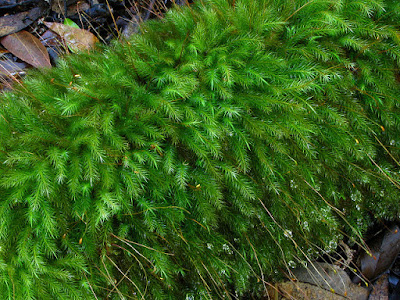 |
| Pyrrhobryum spiniforme growing in Hawaii. Photo by Alan Cressler. |
Pyrrhobryum spiniforme (Hedwig) Mitten (Rhizogoniaceae) is a distinctive moss with upright to leaning leafy shoots with narrow, spiny leaves. The elongate leaves have a strong, conspicuous midrib, and are conspicuously toothed, particularly at the tip and even on the lower side of the midrib. Leaf cells are roundish, with thick walls
This species occurs mostly at tree bases and on rotting logs. The fresh leafy shoots have a feathery appearance, and the leaves become somewhat twisted or curved when dry. The spore capsules are bent to the side, resembling the heads of birds. Stalks of the capsules arise from near the bases of the leafy shoots.
 |
| The narrow leaf has a strong, conspicuous midrib, and prominent teeth along the margins. |
| A dried specimen of Pyrrhobryum spiniforme, from Lassiter 643 (USF) |
| A closer view of the spiny leaf margin and roundish cells of Pyrrhobryum spiniforme. |
widespread around the world
in the tropics, and in North America is found in Florida and the southern parts of Georgia and the Gulf states to Louisiana. In Florida, we have collections only from Highlands County northward into the panhandle, though it might be expected further south with further exploration.
This species was formerly known as Rhizogonium spiniforme, and often filed under that name.











